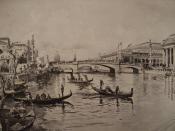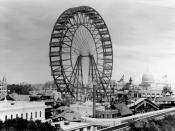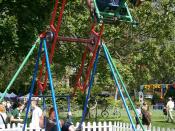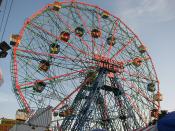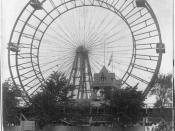Historical events and creative ideas of the times are reflected in the inventions of the period. Throughout history people have always had the need for leisure time, whether it be the simple pleasure of reading a book or the intense high-tech entertainment of today. Different types of entertainment are influenced by historical events, and advancements in technology.
You can talk about the entertainment world for days and days. In the present times we talk about the newest breakup, the new scary movie, or the new ride at six flags. In the past these were not the things that people talked about. They might have talked about the newest disco song, the opening night of Shakespeare's Much Ado About Nothing, who won last night's matches in the Coliseum, or even the newest book.
For a while books and what people could do by themselves were the only type of entertainment that people had.
Later on in ancient Roman times, they used gladiators for entertainment. These gladiators were slaves and they would have to fight for their lives. People liked to see people suffer, so that was the main part of their entertainment of that time period. Then came Shakespearian times. During this time period many people went to plays and many people were in them. Even though in almost all of these plays there were women, there were no actual women playing the part. Throughout history people went to balls for entertainment and to socialize. For a while, people just did what made them happy.
In medieval Europe the idea of the amusement parks began. They were not quite amusement parks, but they were the beginning. They were known as pleasure gardens. During this time they began to pop up on the outskirts of major European cities. These pleasure gardens featured live entertainment, fireworks, dancing, games, and even private amusement rides. They remained popular until the mid 1700's. Their popularity decreased because political unrest caused many gardens to close.
"In the 1800's the growth of the industry moved to America." (3) Following the American Civil War increased urbanization gave rise to electric traction companies (trolleys). Not many people rode these trolleys, so they were looking for a way to make people want to ride them. This resulted in amusement parks. You could find these amusement parks at the end of a trolley line. They consisted of picnic facilities, dance halls, restaurants, games, and a few amusement rides. The parks were immediately successful and soon opened across America.
The amusement park entered its golden era with the 1893 World's Fair in Chicago where the Ferris wheel was built. This huge success dictated the amusement park design for the next 60 years. A man by the name of Paul Boyton was inspired by the Ferris wheel. He was the first person to open a modern amusement park. It was called Paul Boytons Water Chutes. Water Chutes used rides as its main draw rather than picnic facilities or a lake.
The amusement park industry grew tremendously over the next three decades. By 1919 over 1500 parks were in operation in America. In 1929 America entered the Depression. During the Depression many parks closed and by 1935 only about 400 amusement parks remained. During this time what people needed most was entertainment. "Thankfully with the end of the World War II, attendance and revenues grew to new records as parks opened across the USA."(3) George Washington Ferris had a big impact on the entertainment world, specifically the amusement park. He was born in Galesburg, Illinois on February 14th, 1859 and died in 1896 at age 38. When Ferris was a boy, he saw a water wheel and was fascinated by the way it worked. He imagined riding around on the buckets and thought how cool it would be. In school he studied engineering and soon after opened his own bridge inspecting company. It was named G.W.G. Ferris and company.
One day while he was eating dinner, he scribbled a design on a napkin. This design became the Ferris wheel. Ferris was inspired by the water wheel and its mechanical design. "What also inspired him to make the Ferris wheel was the merry-go-round. He wanted to make it vertical" (4) Ferris submitted his idea to the 1893 World's Fair in Chicago. The fair wanted something to rival the Eiffel Tower, which was built at the last World fair in 1889. At first, when Ferris brought up the idea of the vertical wheel, the directors laughed. But after many attempts, the directors granted him a concession. They only did it because they did not think that he would go through with it.
At the1893's World's Fair there was more interest in the Ferris wheel than there was in the Eiffel Tower in 1889's World's Fair. The Tower did not earn any money for just standing there, but, because the wheel was a ride, it made $726,805.50 at the fair, charging 50 cents a ride. This paid for the wheel, which cost $400,000 to make. "The thing that was on many peoples' minds was that the wind would blow it over because, after all, Chicago is nicknamed the windy city." (5) The wheel took about a half an hour to go around once. On the first day, a total of approximately 38,000 people rode the wheel. This was possible because over 2,100 people could ride it at the same time, because the carts were so big.
The carts on the first Ferris wheel were wooden and about the size of a car. Each cart was 27 feet long, 9 feet high and 13 feet broad. There were 36 carts that held 60 riders each. In each cart there were 40 revolving chairs plus about 20 more people could stand.
These carts could hold so many people because of the steel wheel. The outermost wheel was 825 feet of steel, and it had a diameter of 250 feet. It was the largest piece of steel constructed at one time. The axel in the middle was 75 feet long and weighed 140,000 pounds. The whole thing was supported by two 140-foot steel towers. In all, the entire thing weighed 4,800 tons. The metal for the wheel had to be shipped on 150 railroad cars. The wheel reached a height of 266 feet, or 20 stories.
There are many benefits, although some negatives, of the Ferris wheel. Some of these benefits are that it set the tone for modern day amusement parks. These amusement parks brought tourism to states like New Jersey and New York. Because of the popularity of the amusement parks, it brought new jobs. A negative is that it drew people away from other forms of entertainment.
Today in 2003 we take for granted computer games and virtual reality. In looking back in history, people have realized that without the inventors and some simple inventions we would not have all of the high-tech things that we have today. What will the future events bring us next?
